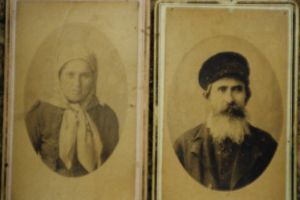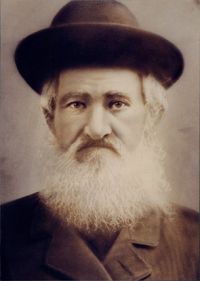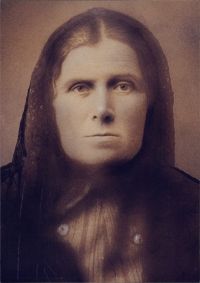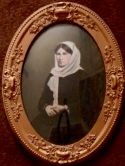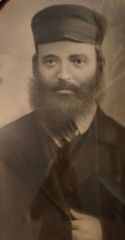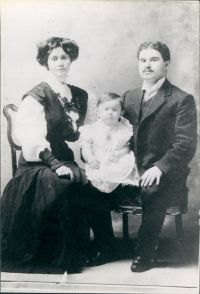Main Page: Difference between revisions
| Line 5: | Line 5: | ||
== Geography and Politics == | == Geography and Politics == | ||
Family origins can be traced to the Pale of Jewish Settlement [https://en.wikipedia.org/wiki/Pale_of_Settlement] in the Russian Empire (now Ukraine) in the early 19th century. This map [http://www.berdichev.org/mappaleofsettlement.htm] shows the extent of the Pale of Settlement where Jews were required to live. The Boguslavsky family origins are in the area south of Kiev in the towns of Boguslav, Imi, Talna and Bobrinets. [https://www.infoplease.com/atlas/europe/ukraine-map] Sixty-three miles south of Kiev is the town Boguslav. Bobrinets is 181 miles SSE of Kiev. Talne is 107 miles S of Kiev. The other town that figures in our history is Imi, likely somewhere between Boguslav and Bobrinets. Later, in the | Family origins can be traced to the Pale of Jewish Settlement [https://en.wikipedia.org/wiki/Pale_of_Settlement] in the Russian Empire (now Ukraine) in the early 19th century. This map [http://www.berdichev.org/mappaleofsettlement.htm] shows the extent of the Pale of Settlement where Jews were required to live. The Boguslavsky family origins are in the area south of Kiev in the towns of Boguslav, Imi, Talna and Bobrinets. [https://www.infoplease.com/atlas/europe/ukraine-map] Sixty-three miles south of Kiev is the town Boguslav. Bobrinets is 181 miles SSE of Kiev. Talne is 107 miles S of Kiev. The other town that figures in our history is Imi, likely somewhere between Boguslav and Bobrinets. Later, in the 20th century, family members (namely, Khana and Myra and their families) settled in the city of Dnepropetrovsk, a large city SE of Kiev. | ||
For Jews, life in the Pale was very much influenced by the unpredictability and violence of pogroms. [https://en.wikipedia.org/wiki/Anti-Jewish_pogroms_in_the_Russian_Empire] | For Jews, life in the Pale was very much influenced by the unpredictability and violence of pogroms. [https://en.wikipedia.org/wiki/Anti-Jewish_pogroms_in_the_Russian_Empire] | ||
Revision as of 20:17, 14 June 2020
History
The Bogage family originated in Eastern Europe as a Jewish family named Boguslavsky. As Jews, their options were limited: governmental regulations dictated where they could live, what occupations they could pursue, and even what names they could use. While these regulations were restrictive for the early Boguslavsky/Bogage family, they can be beneficial to present day researchers who have no verifiable data but who wish to understand the family's origins.
Geography and Politics
Family origins can be traced to the Pale of Jewish Settlement [1] in the Russian Empire (now Ukraine) in the early 19th century. This map [2] shows the extent of the Pale of Settlement where Jews were required to live. The Boguslavsky family origins are in the area south of Kiev in the towns of Boguslav, Imi, Talna and Bobrinets. [3] Sixty-three miles south of Kiev is the town Boguslav. Bobrinets is 181 miles SSE of Kiev. Talne is 107 miles S of Kiev. The other town that figures in our history is Imi, likely somewhere between Boguslav and Bobrinets. Later, in the 20th century, family members (namely, Khana and Myra and their families) settled in the city of Dnepropetrovsk, a large city SE of Kiev.
For Jews, life in the Pale was very much influenced by the unpredictability and violence of pogroms. [4]
Boguslav
Before the 1800’s most Jews did not have family names — no Bogage, no Boguslavsky. People were known only by their father’s given name. Nachmann ben Beryl, for example, would be Nachmann son of Beryl. With the establishment of the Pale of Settlement, came a plethora of rules and regulations for resident Jews including a requirement that Jews take a surname (aka family name). Some Jews took names based on their parent’s given name (Abramowitz = son of Abram), some based on personal description (klein = small), and some based on a geographic place (Warshawski = from Warsaw).
Boguslav [5] is (and was) a town in the Pale of Settlement (now in the country of Ukraine) about 63 miles SSE of Kiev. Knowing that there was/is a town called Boguslav and that a person whose name was Boguslavsky was someone from Boguslav, we can deduce that at some time before 1800 ancestors of the Bogage/Boguslavsky family likely lived in Boguslav.
Imi
The first information we have of our ancestors is through oral history told to us by our grandparents. Our Uncle Yoine told his daughter Pauline what he knew: His zayde Beryl Boguslavsky was born in a “big city” in Russia called Imi (probably around 1830) and his marriage to Bossia (aka Bessie) Meisel was arranged (and said to be a “very good” match) by the couple’s fathers who were both rabbis. Try to find Imi on any map, past or present, and you will come up empty. Yet, according to Uncle Yoine, it was a “big city.” It is likely that Imi was somewhere south of Boguslav.
Genealogy, Part 1 -- The First Two Generations
Beryl and Bossia
Beryl, a rabbi, and Bossia, a midwife, are the first Bogage/Boguslavsky ancestors that we can name. Both the children of rabbis, the arranged marriage of Beryl Boguslavsky and Bossia Meisel was considered a very good match. We know them as the grandparents of the five Bogage siblings to immigrate to the U.S. during the early decades of the 20th century. We don’t know much about them, but we can surmise that as the offspring of rabbis, they were traditional Jews of Eastern Europe in the 19th century.
They lived in the town of Imi and had five children: Nachmann Josef, Label, Cuche, Hannah, and Pinya Raisel. Known in the family as Yussel, Nachmann Josef was born around 1850. Of his siblings, we know only that his sister Pinya Raisel married Moishe Skolnick, a rabbi and a maggid. They had two children, a daughter Feige and a son. Following Pinya Raisel's death, Feige was raised by Hannah, sister of Pinya Raisel and Nachman Josef.
The children of Beryl and Bossia
Nachmann Josef
Known in the family as Yussel, Nachmann Josef was born in Imi probably around 1850. His marriage to Kraina (also spelled Croyne), daughter of Yonah and Rosa Hussan from the town of Talna, was arranged by their parents. Her father Yonah was a chazan or cantor, hence the name Yonah Hussan. It is likely that he was not the first chazan in his family.
The couple moved to Talna while Nachmann Josef, who was studying to become a malamud (teacher), chazan (cantor), and magid (preacher), attended Yeshiva Itzchak El Huna in that town. While they lived in Talna, the couple had three children: Chana, Ralph, and Myra. After Nachmann Josef completed his studies, the family moved to Bobrinets, where he worked as a melamed and a magid and was often paid with bartered chickens and the like.
In Bobrynets the family lived in a simple home with an earthen floor, a roof of straw, and a fireplace that was used for both cooking and heating the room. Kerosene lamps lit the home at night; a well behind the home provided water; and an outhouse behind the house was the toilet.
Kept in a small barn next to the house, six goats provided the family with milk and cheese. The goats were taken to the field every morning and brought back to the barn every evening to be milked. The family also kept chickens and had a small vegetable garden.
This was a time before automobiles, before paved roads, a time when vehicles were horses, carriages, and carts; and a time when muddy trails could halt all travel. It was a time before tv, radio, internet. Communication was challenging.
Not only Jews lived in Bobrynets, but those who did lived together in the Jewish quarter (ghetto) and had a shul, a Talmud Torah, a mikvah, a cemetery, and retail establishments such as a kosher butcher, a tailor, and a hat maker.
Pinya Raisel
Of Nachmann Josef's siblings, we know only that his sister Pinya Raisel married Moishe Skolnick, a rabbi and a maggid. They had two children, a daughter Feige and a son. Following Pinya Raisel's death, Feige was raised by Hannah, sister of Pinya Raisel and Nachman Josef. f his Nachmann Josef's siblings, we know only that his sister Pinya Raisel married Moishe Skolnick, a rabbi and a maggid. They had two children, a daughter Feige and a son who, it is said, married and had two children. Following Pinya Raisel's death, Feige was raised by Hannah, sister of Pinya Raisel and Nachmann Josef.
The Family Business
Beryl Boguslavsky was a rabbi. We are told that Moishe Skolnick was a rabbi and a maggid, and Nachman Josef worked as a melamed and a maggid. His father-in-law, Yonah Hussan was a cantor. In 19th century Eastern Europe, these four occupations (rabbi, melamed, maggid, and cantor) were related, and may have even overlapped, but they were separate. It is interesting to note, as well, that they all carried with them a kind of respect not affiliated with other occupations. (When Nachman Josef’s name was mentioned formally, it was accompanied by his title: ha-levi ha-maggid.)
According to Yaffa Eliach, “The Eastern European rabbi in general and the shtetl rabbi in particular was a guiding and unifying force. . .He was perceived as the highest moral authority in the community; the embodiment of Judaism itself, and honored accordingly. . . In time of trouble. . . he was expected to guide the community to safety. He opened all public and private events with a speech or benediction.” (There Once Was a World, p. 94)
The melamed (the Hebrew word for teacher) was a teacher of children. It was a position of respect, but carried a very low salary. The chazan, or cantor, was responsible for leading services in the synagogue and providing the musical accompaniment to prayer. The maggid was an occupation more like the modern equivalent of rabbi. The name literally means “to preach” or “to say,” and the maggid was, often, the voice of the people. His major function was to preach and lift up his audience in contrast to the rabbis, who would offer advice on halakhic issues. His concern was moral rather than legal.
Eliach states that “Some historians view the maggidim. . .as a kind of non-establishment intelligentsia, having much of the learning and influence of the traditional scholar but without being in any way beholden to the upper strata of Jewish society. The maggidim were thus a great moral force within the community, free to speak their minds and, from their unique vantage point outside the establishment, to criticize both the leaders and the people.” (p. 120)
The Boguslavsky family business, so to speak, was based on learning, teaching, ideas, and communicating that to the people of the community.
Genealogy, Part 2, The Third Generation
Nachmann Josef and Croyne Boguslavsky had nine children, five of whom emigrated to the U.S. in the early years of the 20th century:
- Khana -- b. 1872? Talna, d. 1941/Dnepropetrovsk
- Rafuel -- b. 1884 Talna,d. 22 September 1957/Worcester, MA.
- Myra -- b. 1885 Talna, d. 1977 Dnepropetrovsk
- Israel (Harry) -- b. 1887 Bobrinets, d. 1952 Flushing, NY
- Chaika -- b. 1890 Bobrinets, d. 1980
- Yonah (Jonah, Joe) -- b. 3/5/1891 Bobrinets, d. 7/1985
- Lazer (Louis) -- b. 6/1/1984 Bobrinets, d. 11/14/1984 Trenton, NJ
- Label -- b. 1898 Bobrinets, d. 1958 Russia
- Rose -- b. 1901 Bobrinets, d. 1989
Khana/Chana
Khana Boguslavsky, eldest child of Nachmann Josef and Croyne Boguslavsky, was born in Talne, probably around 1872. She married a man named Boris who divorced her, we were told, because she was unable to conceive a child. However, on a basic family tree drawn by one of our Russian cousins, we learn that Khana had five children (Yoine, Pinya, Yisrul, Vladimir, and Beryl) who lived in Tashkent in recent years. Media:Khana_Boguslavsky.jpg At present we have no further information about whether this branch of the family emigrated to Israel. Information posted on the Yad Vashem website by Khana's grandson Yaakov Gershovich indicates that her husband was Yudel Gershovich, that they had five children, and had lived in Dnepropetrovsk, a city not far from Bobrynets. The record also indicates that she was murdered in Dnepropetrovsk, where she had lived, in 1941. (Beginning in mid-1941, German troops began rounding up Jews and taking them to empty quarries, ravines, or anti tank ditches where they were shot and buried on the spot.)
Boguslavsky cousins who were not able to leave the USSR until the 1990’s say that her family was planning to flee from the Nazis and travel to Tashkent in Uzbekistan but Khana refused to leave, saying that she was old and would be a burden to them. The family fled and Khana Boguslavsky Gershovich remained in Dnepropetrovsk.
Rafuel/Raphael/Ralph
Ralph, the eldest son, was born in Talna, March 24, 1884. With his younger brother Israel (later called Harry), he was sent to Kiev to learn the watchmaking trade. Since very few Jews were permitted to live in Kiev and even fewer were permitted to attend this school, it was considered a great honor to be admitted to the school. Despite the fact that it posed a financial burden on the family, the brothers went to Kiev to learn the trade.
Ralph probably married Minnie (known as Manya in the family) Goldovsky in Bobrinets before they emigrated together to the U.S. in 1906. By 1910 (according to the US census), they were living in Worcester, MA and had changed their name to Bogage. Ralph worked as a watchmaker (jeweler) in various locations on Main Street in Worcester, eventually opening his own jewelry store there.
Ralph and Manya had two sons: Jonah Edward Bogage (known as Eddie/Edward), born 3 October 1906, died 15 December 1949 in Worcester; and Bernard (known as Bernie), born 13 October 1908, in Worcester, died 12 April 2000 in Florida. Media:Ralph_Bogage_1.jpg
Myra/Maria
Myra was born in Talna in 1885 and died in 1977 in Dnepropetrovsk, a city 243 miles southeast of Kiev in Ukraine. She married and had four children: Boris, Fena, Rosa, and Estelle (known as Etel, whom we met with her daughter Tana in Israel in 2006).
Media: Etel_2006_in_Israel.jpg
References
A person in the Bogage family is Estelle Sassaman.
MediaWiki has been installed.
Consult the User's Guide for information on using the wiki software.
